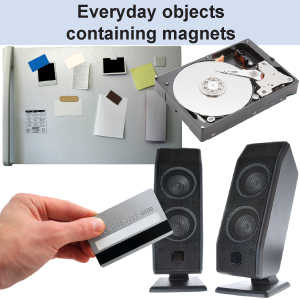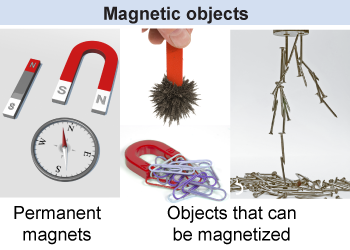|
What does the word “magnet” mean to you? Do you think of a bar magnet, horseshoe-shaped magnet, or a refrigerator magnet? Do you think of how a compass responds to the magnetic field of Earth? Magnetism is the property of a material or object to attract other objects made out of iron, magnetite, or steel. This fascinating phenomenon has been a foundation of technology since ancient times. This section introduces the fundamental ideas underlying magnetism. 
|
Magnets
|
 Magnets abound in technology. Computer hard disk drives use magnets to read and write data. Magnets are used in speakers in home stereos and headphones. Magnetic clasps are on many handbags. Credit cards and ATM cards store data on magnetized stripes that are read by swiping the card through a reader with additional magnetic devices. Magnets are in electric generators that convert mechanical energy to electrical energy. Junkyards use large magnets to lift scrap metal and cars. Magnetic switches are part of many security alarm systems.
Magnets abound in technology. Computer hard disk drives use magnets to read and write data. Magnets are used in speakers in home stereos and headphones. Magnetic clasps are on many handbags. Credit cards and ATM cards store data on magnetized stripes that are read by swiping the card through a reader with additional magnetic devices. Magnets are in electric generators that convert mechanical energy to electrical energy. Junkyards use large magnets to lift scrap metal and cars. Magnetic switches are part of many security alarm systems. 
|
 Magnetic objects are generally grouped into two categories: permanent magnets and objects that can be magnetized. A permanent magnet retains its magnetic properties at all times, regardless of whether or not it is near another magnetic object. A steel refrigerator door, however, is not a permanent magnet. The steel in the door has magnetic properties only when another magnetic object, such as a refrigerator magnet, is brought near enough to magnetize it. Iron, steel, nickel, and cobalt, as well as some naturally occurring minerals such as lodestone, can be magnetized.
Magnetic objects are generally grouped into two categories: permanent magnets and objects that can be magnetized. A permanent magnet retains its magnetic properties at all times, regardless of whether or not it is near another magnetic object. A steel refrigerator door, however, is not a permanent magnet. The steel in the door has magnetic properties only when another magnetic object, such as a refrigerator magnet, is brought near enough to magnetize it. Iron, steel, nickel, and cobalt, as well as some naturally occurring minerals such as lodestone, can be magnetized. 
|
Most materials do not have noticeable magnetic properties. Magnetic influences pass right through them. Paper is a good example. Many people use magnets to hold pieces of paper on steel refrigerator doors. The magnetic force between a magnet and the steel passes right through the paper. Wood, plastic, and glass are other materials that do not block the influence of magnets. Iron and some other metals that are good conductors, however, can block or change the magnetic activity of nearby objects. 
|
There are no liquid magnets. All magnets are solids. This is because the kind of magnetic effects we are discussing come from the small-scale organization of atoms within a material. Anything that disrupts the orderly arrangement of atoms, such as being melted, destroys ordinary magnetic effects. This is why heating up a permanent magnet past a certain temperature causes it to lose its magnetism. 
|
Classify each of the following objects as a permanent magnet, an object able to be magnetized, or neither. - paper clip
- wooden table
- car body
- compass needle
 |
- Paper clips can be magnetized because they are made of steel, but without a magnet around, they aren’t magnetized.
- A wooden table cannot become magnetized.
- A car body is made of a metal that can become magnetized if brought into a magnetic field.
- A compass has a needle that is always magnetized, so it is a permanent magnet.

|
| |
|

